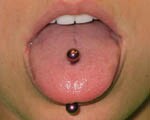Stainless steel studs may collect more bacteria than plastic studs, potentially increasing the risk of infection and other complications in individuals with tongue piercing.

Tooth chipping and receding gums, as well as gum disease, are some of the long-term complications associated with tongue piercing, prior research shows. Early complications include pain, swelling, prolonged bleeding and swallowing difficulties. What's more, the mouth contains so many bacteria that the piercing procedure itself may increase the risk of infection, one of the most common piercing complications.
To investigate whether there are microbiological differences in bacterial samples collected from tongue piercings made of different materials, a total of 85 participants, who ranged in age from 16 to 36 years, with tongue piercing were followed. After a baseline dental examination, sterile piercings of four common piercing materials: stainless steel, titanium, or one of two types of plastic was randomly allocated to the participants. The studs were removed after two weeks and microbiological samples were collected from the stud, the piercing site and the tongue.
A total of 80 different species of bacteria were collected from the various sites and the tongue harboured most of the bacteria. Eighteen bacterial species were more abundant in the piercing site than on the tongue and six species were more prevalent on studs than the tongue. Eight other species were more plentiful on studs than in piercing sites. Stainless steel studs were found to be the biggest culprit, accounting for the highest bacteria counts, followed, to a much lesser degree, by titanium studs. Bacteria found on these metals included those known to cause body-wide infections, such as Staphylococcus aureus and Haemophilus influenza. Both metals had significantly greater bacteria counts than did plastic studs.
The researchers recommended that consumers should avoid stainless steel and titanium studs in favour of plastic, not only because of bacteria and a potentially higher risk of local infection of the piercing channel, but also because of the risk of tooth chipping and gum recession.
One source of infection may be thin layers of bacteria, called biofilms that coat piercings and act as a reservoir for germs. The study speculated that using piercing materials that were less susceptible to biofilm accumulation may reduce infection risk. They, however, warn that no matter what material the stud is made of, it's going to hit the back of the front teeth, and most of the patients develop either a gum infection or some sort of injury to their teeth because of the tongue ring.
DoctorNDTV is the one stop site for all your health needs providing the most credible health information, health news and tips with expert advice on healthy living, diet plans, informative videos etc. You can get the most relevant and accurate info you need about health problems like diabetes, cancer, pregnancy, HIV and AIDS, weight loss and many other lifestyle diseases. We have a panel of over 350 experts who help us develop content by giving their valuable inputs and bringing to us the latest in the world of healthcare.












